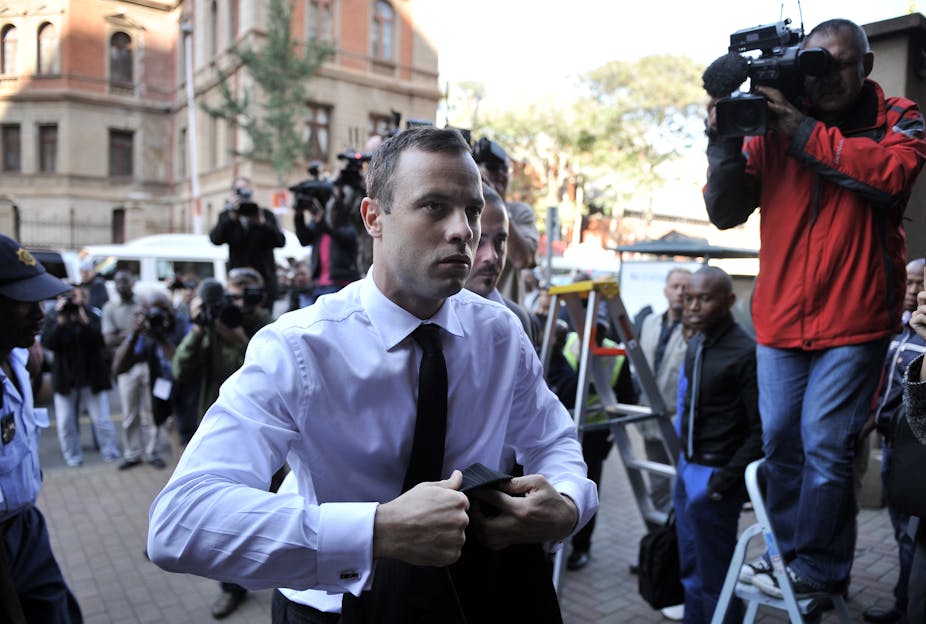The murder trial of Oscar Pistorius is changing South Africa’s media ecology. It is the country’s first criminal trial to be covered fully on social media and live television, and both journalists and judges have had to learn new rules and practices on the fly.
Previously, we have had television cameras covering the high-level legal debate of our Constitutional Court and the occasional judgement in a major case of national important or commission of inquiry. But a precedent was set when it was ruled in this case that almost all of it could be broadcast live. Only “private”, non-expert, witnesses could opt out of the television coverage, though their audio would still be run live.
This was a step forward for the notion of open justice, though there was also some backtracking when an irritated judge stopped all coverage during the presentation of post mortem results (which have previously been public documents), including tweeting from the court. She had to quickly backtrack on the Twitter ban, when it became obvious that she had not understood the difficulty of containing social media.
Media explosion
South Africa has three new 24/7 news channels, as well as one pop-up TV channel and one pop-up radio channel, the latter two created especially for the Pistorius trial. This has led to unprecedented levels of coverage, as well as analysis and debate on every aspect of the procedure and evidence.
Flip between talk radio and live television and you will hear analysts and commentators dissecting on every aspect of the trial. Much of it is trivia about Pistorius’ every gesture, but there is also discussion about the legal procedure, the meaning of evidence and the performance of the teams of lawyers.

British viewers would be surprised at some of the discussion, with senior legal figures commenting on the performance of witnesses and interpreting evidence with little restraint.
It appears that there are few rules and restrictions. South African law has been relaxed in this regard, with a Constitutional Court ruling in 2007 that media could only be in contempt of court if: “the prejudice that the publication might cause to the administration of justice is demonstrable and substantial and there is a real risk that the prejudice will occur if publication takes place”.
This has opened wide the door to commentary and speculation, especially in the absence of a jury system. The free-for-all which has followed has raised the question of whether this has served the public well.
Better informed
Dunstan Mlambo, the judge who allowed the cameras into the Pistorius court argued that it would educate the public on the finer points of the justice system and demonstrate that all are treated equally before the law.
There can be little doubt that many South Africans are now much better informed about the workings of the courts, and the realisation that it is much more tedious and complicated than the television dramas which usually dominate our screens. If the purpose was to get South Africans engaged in issues of the law and justice system, it has been a roaring success.
Less clear is whether the judge was right that South Africans would see a display of equal treatment before the law. On show is very clearly a rich person’s justice and the fact that a major court case will bankrupt even the well-off. What we are seeing on our screens every day – including the best lawyers of the land and the court officers on their best behaviour – is a far cry from any ordinary person’s experience of our justice system.
Two other cases have been highlighted during the trial. The first was another murder trial just up the court corridor from the Pistorius case, also one of intimate partner violence. It received almost no attention until a foreign correspondent wandered into that court during a quiet moment in the Pistorius trial, and provided a much clearer demonstration of the extent of the problem of domestic violence.
A second case featured another disabled accused, known only as Prisoner X for his own protection, a paraplegic who had been held without bail for two years under the most appalling conditions and without proper medical care.
What we have not seen much of yet in the South African media is an examination of some of the issues which arise out of the trial. These include the gun culture of much of South Africa’s elite which makes the carrying and firing of weaponry a routine part of everyday life; the high levels of gender-based violence, particularly between intimate partners; and the fear of faceless intruders which runs through a society with high levels of violent crime.
It is hard not to think about these things as the trial unfolds, but it often feels that South Africans are trying as hard as they can to ignore them. But it is clear that South Africa’s media environment will not be the same. Coverage – and the conversation around it – is being driven by social media. Conventional media tries to keep up by covering the Twitter and Facebook chatter second-hand.
And the daily newspapers are struggling to keep up, accelerating a serious decline which started a few years ago. Almost all of our daily papers have lost significant circulation in the last two years, which has led to large-scale newsroom cutbacks. The big story of Nelson Mandela’s death at the end of last year brought some relief for sales, but a glance at the dailies now show that they are lagging behind the more nimble electronic media. Suddenly, the country has more live news broadcasting channels than ever before.

